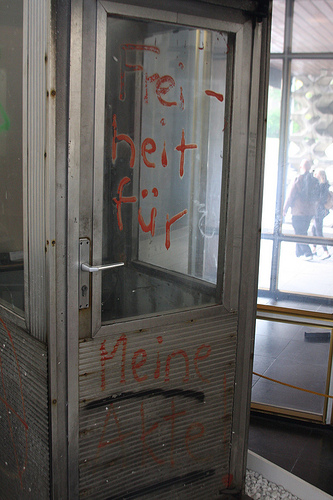The records continuum model was developed by Monash University’s Frank Upward in the mid 1990s as a way of expressing the many recordkeeping processes that occur in society and the contingencies inherent in them. It explains the way in which records are made, organised, shared and used in a variety of times, places and contexts under the influence of changing legal, political and practical constraints. It has been written on extensively, and there are some references included below, so I do not propose to expand on it in detail here.
My reason for introducing it is that as the events of CableGate 2 unfolded over the last couple of weeks I was struck with the way in which the expanded possibilities for use, sharing and reclaiming records we have seen with the cables release have demonstrated what, in continuum terms, is labelled ‘Fourth dimension’ recordkeeping; that is, the formation of a pluralised archive which exists beyond spatial and temporal boundaries, transcends state and economic controls and which actually encourages and incorporates people’s participation and comment. An archive which reflects a truer, less filtered and more inclusive perspective on the events documented in the records.
The qualities that set CableGate 2 apart from traditional archives and even from prior releases by WikiLeaks, making it a truly ‘Fourth dimensional’ archive, are essentially about participation and plurality.
Participation
This archive is still forming (and will continue to); as comment, debate, challenge and reflection on cables proliferates in blogs, on Twitter, in the traditional media, in public art, academic journals and elsewhere. Developers are building tools to interrogate, reuse or visualise the cables data in a huge variety of ways. How many times is the word ‘rape’ mentioned? Can we see the relationships between cables from a certain period of time and location? The Cablegatesearch tool http://www.cablegatesearch.net now has a commenting facility. Are you personally mentioned in a cable? Is what is said true? The vision of user contributed analysis and comment on whistleblower releases originally conceived of by WikiLeaks is in full flight.
Plurality
The duplication and dissemination of the cable set across thousands of technology platforms and in unknown numbers of online contexts instantiates it as a collective archive capable of being owned by everyone and no-one; and removes it from the kind of political interference which places barriers between people and records in traditional archives. This release by mirroring, bit torrent and other forms of mass sharing allows it to serve the needs of the broadest possible concept of ‘societal totality’. It sits within what archivists would term the 'ambient' realm; above the functions and structures of governments and other juridical entities, in touch with the broadest possible themes of human experience as played out on the internet.

Photo: 'Freedom for my file!' from hc saustrop's photostream
Much has been said about whether it was right for WikiLeaks to release the full set of unredacted cables after they were leaked. In particular, the question of risk to individuals named in cables has, rightly, concerned many. My opinion on this is shaped by pragmatism (the cables were already in the public domain) but also an understanding of the nexus between records and power. By leaving pockets of cables lurking on the internet without a very public release left the chance that the communities of interest that have now sprung up around the cables would not have formed. The names and details of informants, journalists and activists may not have received the full glare of light that CableGate 2 has afforded them. In my view, this would have left them with less power and at greater risk. When civic groups stormed the Stasi headquarters in East Berlin in 1990 they shouted ‘Freiheit für meine Akte!’ (Freedom for my file!). Now with CableGate 2 we have freedom for the evidence of a huge array of international events affecting millions of people. Participate in it.
References
Cablegate's cables: Full-text search
Eric Ketelaar, ‘Recordkeeping and societal power’ in McKemmish, Piggott, Reed & Upward (eds) Archives: Recordkeeping in Society, Charles Sturt University, Wagga Wagga, 2005
Michael Piggott and Sue McKemmish ‘Recordkeeping, Reconciliation and Political Reality’ Australian Society of Archivists Annual Conference, Sydney, August, 2002
Frank Upward, ‘Structuring the Records Continuum - Part One: Postcustodial Principles and Properties’ First published in Archives and Manuscripts, vol. 24, no. 2, 1996, pp. 268-285
Frank Upward, ‘Structuring the Records Continuum, Part Two: Structuration Theory and Recordkeeping’ First published in Archives and Manuscripts, vol. 25, no. 1, May 1997, pp. 10-35
WikiLeaks, Secret US Embassy Cables
Theme by Danetsoft and Danang Probo Sayekti inspired by Maksimer